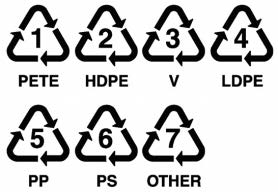PLASTICS
In your quest to go green, use this guide to use and sort plastic. The number, usually found with a triangle symbol on a container, indicates the type of resin used to produce the plastic. Visit EARTH911.COM for recycling information in your state.
NUMBER 1 • PETE or PET (polyethylene terephthalate)
IS USED IN microwavable food trays; salad dressing, soft drink, water, and juice bottles
STATUS hard to clean; absorbs bacteria and flavors; avoid reusing
IS RECYCLED TO MAKE carpet, furniture, new containers, Polar fleece
NUMBER 2 • HDPE (high-density polyethylene)
IS USED IN household cleaner and shampoo bottles, milk jugs, yogurt tubs
STATUS transmits no known chemicals into food
IS RECYCLED TO MAKE detergent bottles, fencing, floor tiles, pens
NUMBER 3 • V or PVC (vinyl)
IS USED IN cooking oil bottles, clear food packaging, mouthwash bottles
STATUS believed to contain phalates that interfere with hormonal development; avoid
IS RECYCLED TO MAKE cables, mudflaps, paneling, roadway gutters
NUMBER 4 • LDPE (low-density polyethylene)
IS USED IN bread and shopping bags, carpet, clothing, furniture
STATUS transmits no known chemicals into food
IS RECYCLED TO MAKE envelopes, floor tiles, lumber, trash-can liners
NUMBER 5 • PP (polypropylene)
IS USED IN ketchup bottles, medicine and syrup bottles, drinking straws
STATUS transmits no known chemicals into food
IS RECYCLED TO MAKE battery cables, brooms, ice scrapers, rakes
NUMBER 6 • PS (polystyrene)
IS USED IN disposable cups and plates, egg cartons, take-out containers
STATUS is believed to leach styrene, a possible human carcinogen, into food; avoid
IS RECYCLED TO MAKE foam packaging, insulation, light switchplates, rulers
NUMBER 7 • Other (miscellaneous)
IS USED IN 3- and 5-gallon water jugs, nylon, some food containers
STATUS contains bisphenol A, which has been linked to heart disease and obesity; avoid
IS RECYCLED TO MAKE custom-made products
